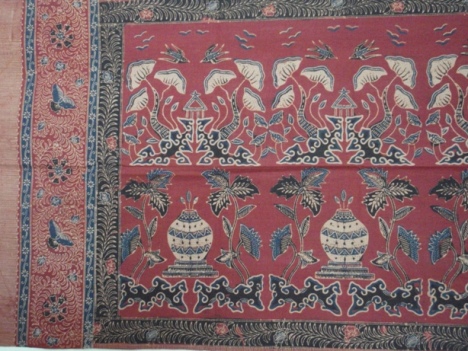Today, we shall be seeing how batik is uniquely used in South-East Asia as a baby carrier and shoulder piece.
Kain gendongan means a baby carrrier (kain = cloth, gendong = to carry, gendongan = carrier). While a selendang or shoulder piece is sometimes worn by womenfolk in the Nusantara region (roughly present day Malaysia, Indonesia, Singapore, Brunei and some parts of the Phillipines) to sling onto their shoulders and can be easily used to shield their heads from the rays of the tropical sun, or to cover their hair when needed to), or even to bundle up things.
Here are 2 examples of these long cloths which can be used as either a kain gendongan or selendang, or naturally, both. These traditional cloths like these are rich in traditional symbols which often convey specific meanings.
Piece 1: A Javanese-styled batik cap piece – kain gendongan / selendang
Dimension: 160 X 51.5 cm
This harmonious piece comes in the more bold, sombre colours which give it an impression of some of the old Cirebon batiks in terms of colour choice and motifs. While the piece is a batik cap piece, and may not be that old in terms of age, it is rich in traditional symbols.
The pavilion amidst the rocky formations recall the symbol of taman arum (literally, fragrant gardens or sometimes called meditative gardens) in Cirebon iconography, may indicate a dimension of spiritual progress. The layered rock formations are also known as wadas (coral rock formations) and can be attributed to Chinese influences in the local batik designs.
Piece 2: A Chinese influenced batik cap piece – kain gendongan / selendang
Dimension: 176 X 53 cm

The piece depicts phoenixes (burung cenderawasih) (or some people say, the peacock, or burung merak) perching on flowering branches of flowers. The phoenix abound in old Malay and Chinese legends. In Malay legends, it is believed to come from the heavens or paradise, and is said to be fragrant and can bring luck to the owner. Even when dead, it is said that it will not rot, and it is believed that its feathers have magical and healing powers. In China, it is a symbol of the Chinese Empress and the bird is said to appear only in times of great prosperity and peace. This piece, which comes from Indonesia, has some ringings of Chinese influences and tastes about it such as the pastel colours that the local Peranakan Chinese community favours and also the phoenix on a peony branch motif which is a favourite symbol. In Indonesia where there is much criss-cross of cultures, it could have been used by either the local people or even the local Peranakan Chinese community. Whatever so, the phoenix and luxuriant blooms carry wishes of blessings and happiness to the wearer.
We welcome anyone who has any sharings to add the meanings of the motifs, or about kain gendongan or selendang 🙂
Filed under: Batik Review | Tagged: baby carrier, batik, batik cap, chinese batik, javanese batik, kain gendongan, selendang, shoulder cloth | Leave a comment »



